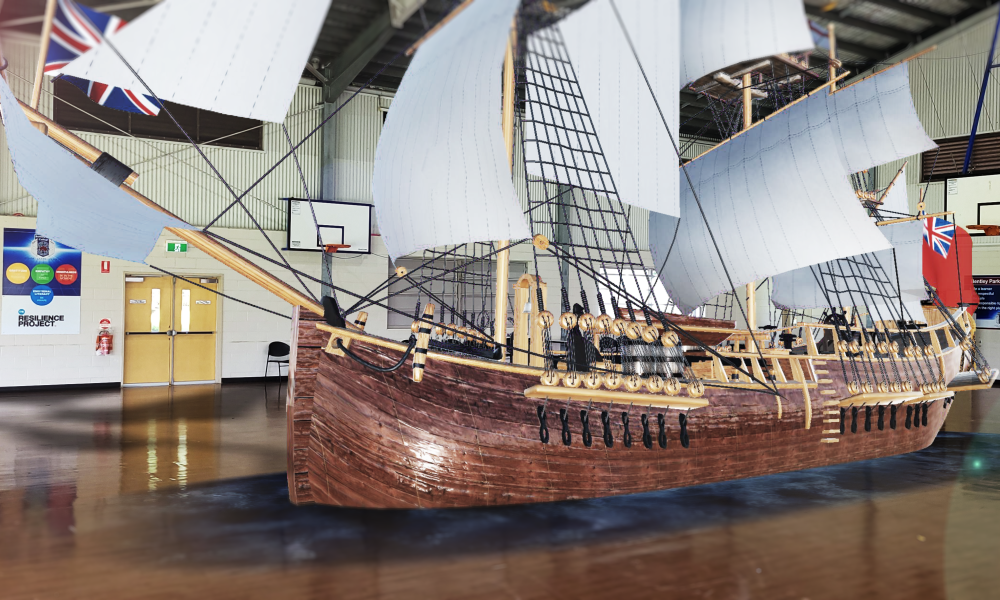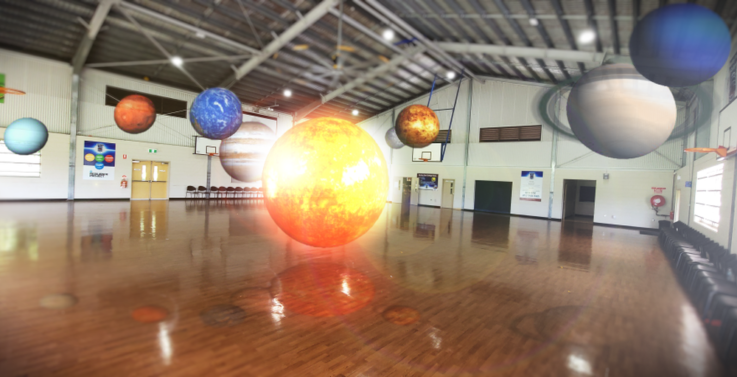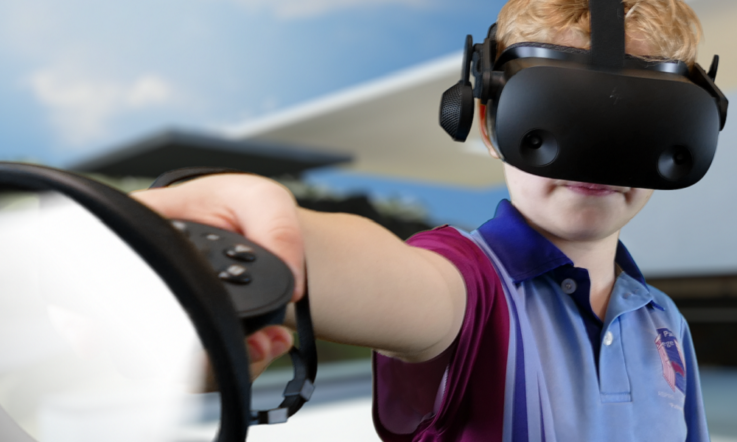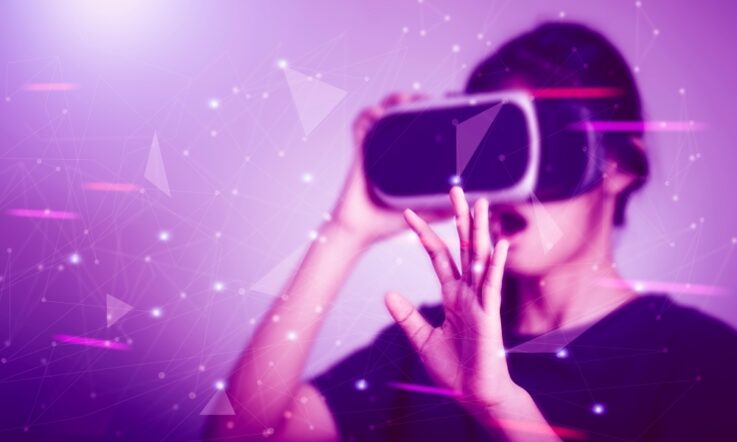Can you imagine what life was like on the Endeavour, especially when your survival depended on it? Can you visualise Port Jackson, its location and the layout of this, the first British colony in Australia? Videos and texts will provide some insights, but an Augmented Reality (AR) experience will allow you to move around, to actively explore and learn about these things in a whole new way.
This is the experience now available to primary level students – the above is just one of the AR modules designed and developed by the Learning & Design Hub for use by students at Foundation to Year 6 levels in Queensland Department of Education schools. But why introduce AR as a tool for education at primary levels?
Preparing for a digital future
The Hub’s decision to begin developing modules for primary students was, and is, based on a conviction that effective use of immersive technologies enhances teaching and learning, improving student achievement and developing digitally competent and confident young people for a technological world that is continually changing.
As the Queensland Department of Education (2022) states in its Digital Strategy 2022-2026, we need to provide a digital future that ‘better prepares Queenslanders to work, learn, play and succeed in a world with a constantly evolving technology landscape’. It further argues that ‘digital capability and inclusion are essential for our workforce and students’ success’ and that ‘modern learning technologies are integral to collaboration beyond the classroom to enhance the way we teach, learn and work’. To achieve these goals, we need to ‘invest in our children, students and workforce to build their digital capability and inclusive practices to thrive in a rapidly changing digital future’ and to do this by upgrading and modernising ‘our digital teaching and learning, collaboration, and communication capacity’.
Differentiation – building in, not bolting on
The above statements resonate with the vision and mission of the Learning & Design Hub. Our decision to design AR as a learning and teaching tool for use in primary programs was also, in a practical sense, reinforced by the fact that we could use the Apple School Manager System for iPads – devices that many schools already own and use.
In this venture, we have been acutely conscious of the difference between the use of our Virtual Reality (VR) modules at a secondary level and the provision of AR modules that will cater for the learning needs of primary aged students.
Our module design needs to consider students’ literacy capabilities and their capacity to carry out challenging cognitive tasks. As a result, we strive to ensure that all modules open up learning opportunities for all students, regardless of their academic abilities, by building in learning differentiation rather than simply bolting on at a later stage.
As we have done in our design of VR modules, ease of use, simple consistent mechanics and maximum learning flexibility are hallmarks of each module. Aware of the dangers of information overload, written text within the software is kept to a minimum and ‘text to speech’ supports student understanding of the content.
Teaching the students how to use the technology and software was a simple task. Why not use AR to teach how to use AR? Enter Professor Chip!
We have designed a training module featuring a robotic character that walks the students step by step through the mechanics of the AR experience. The Year 4 students who trialled the module were delighted by the process, picking up the key instructions straight away and applying them a couple of days later to their learning in one of the Science modules.
The AR learning experience
All modules are not simply based on the Australian Curriculum, but are fully aligned with Version 9.0. It could be said that the curriculum documents constitute our design manual and generate the content and learning activities of each unique module.
The AR software provides scope for individual, paired, small group and large group engagement. As with VR, AR modules provide custom-built original software and a comprehensive range of supporting activities, each with its own specifically designed task sheets.
Rather than a passive experience, a Guided Inquiry pedagogy stimulates active learning within the software and supporting tasks. Student agency is paramount. Students are motivated to explore, examine, discover and create for themselves.
The teacher’s journey
As our first article on our work with Augmented Reality observed, the use of immersive technology in learning and teaching is pretty much shaped by the teacher’s capabilities and readiness to open up to new pedagogical practices. The AR learning experience requires that the teacher’s role is that of facilitator – guiding and supporting the student-centred learning experience.
We have rarely encountered open hostility to the introduction of technology in learning programs, but we have met many teachers who question their ability to integrate it into their planning. We often hear ‘But I don’t know anything about technology!”. Some teachers are anxious about setting out on a new and challenging journey (a bit like sailing on the Endeavour?). However, when they confront their fears, face the risks and try it out, we have found that their students’ vibrant and excited engagement in the task brings about a transformation in their thinking and willingness to use the technology again.
Final thoughts
The Learning & Design Hub journey is one of innovation, creativity and joy. We are fortunate indeed to see teachers and students engage in new and exciting ways with the modules that we have designed and developed.
We have found this journey to be constantly evolving, with new ideas emerging as we respond to changing needs and changing technology.
We strive to be agents of an ever-changing technological landscape and trust that our software and resources will bring rich benefits to all learners, teachers and students alike.
We need to keep in mind that there is always a need ‘…to move past optimism and pessimism and start thinking about what we do and why we do it. If we have a new technology, it's not a hammer looking for a nail. It's a set of opportunities and challenges... It's an opportunity to think in a new way about the tasks we want children to be able to do in the real world.’ (Cassell, as quoted in Sobel, 2019, p.12).
Stay tuned for the final article in this series by Dr Susan O’Donnell and Adrian Rayner, which discusses some of the prior teacher concerns about use of immersive technologies and how to build the capacity of classroom practitioners.
References
Sobel, K. (2019). Immersive media and child development: Synthesis of a cross-sectoral meeting on virtual, augmented, and mixed reality and young children. The Joan Ganz Cooney Center at Sesame Workshop. https://joanganzcooneycenter.org/publication/immersive-media-and-child-development/
Queensland Department of Education. (2022). Digital Strategy 2022-26. A great digital future for every Queenslander. Queensland Government. https://alt-qed.qed.qld.gov.au/our-publications/strategiesandplans/Documents/itb-digital-strategy.pdf (4.2MB). Available for download at https://alt-qed.qed.qld.gov.au/publications/strategies/digital-strategy
When you incorporate a new piece of technology into your teaching, what are the learning outcomes you hope to achieve?
How could integrating the use of AR into learning activities be used to complement a unit of work you have coming up? What are the barriers to making this happen and how could you work with your colleagues and wider networks to overcome these?



